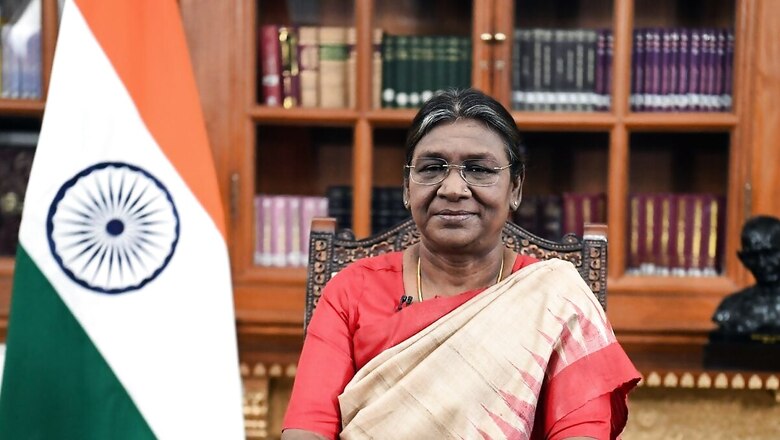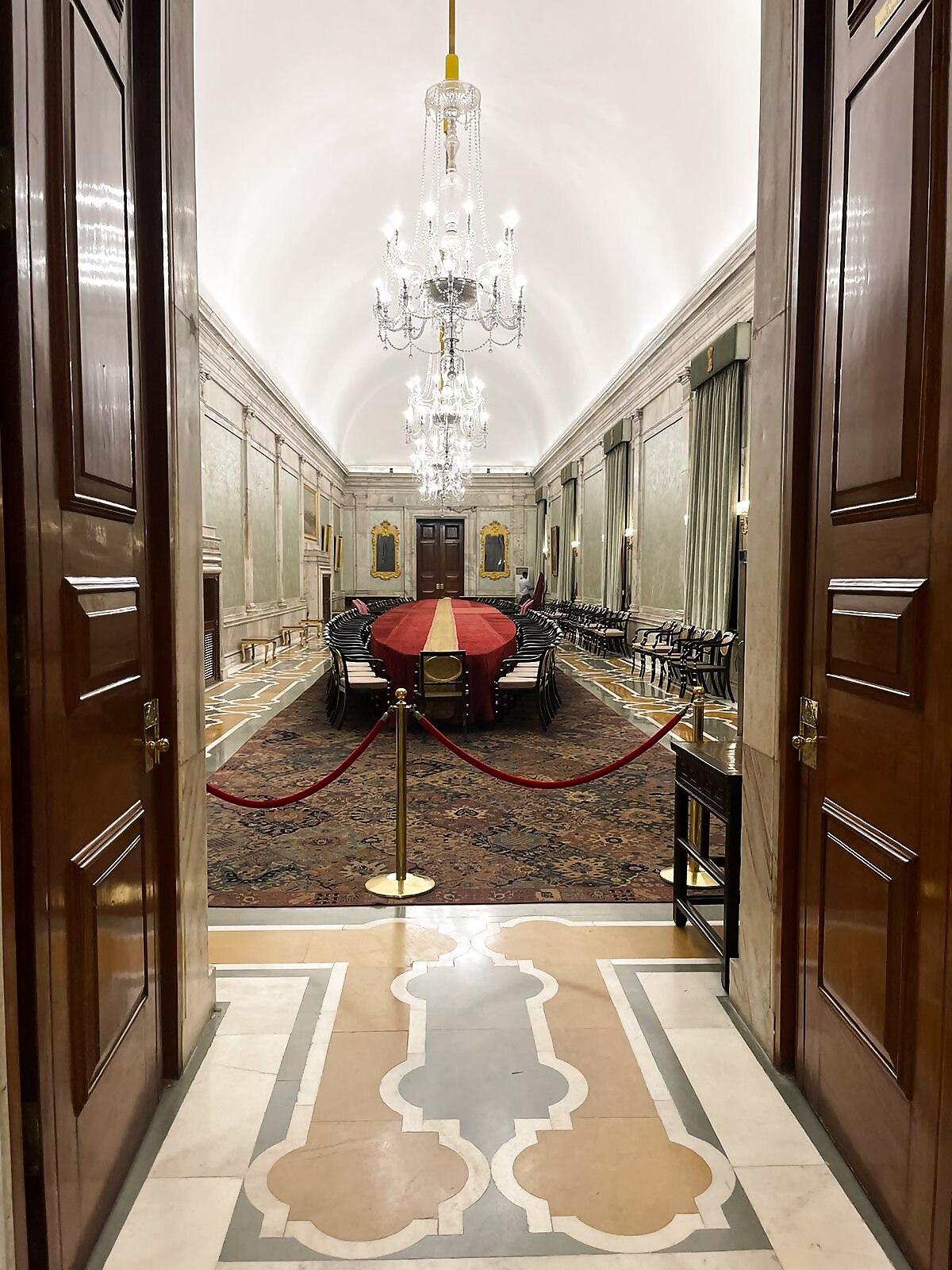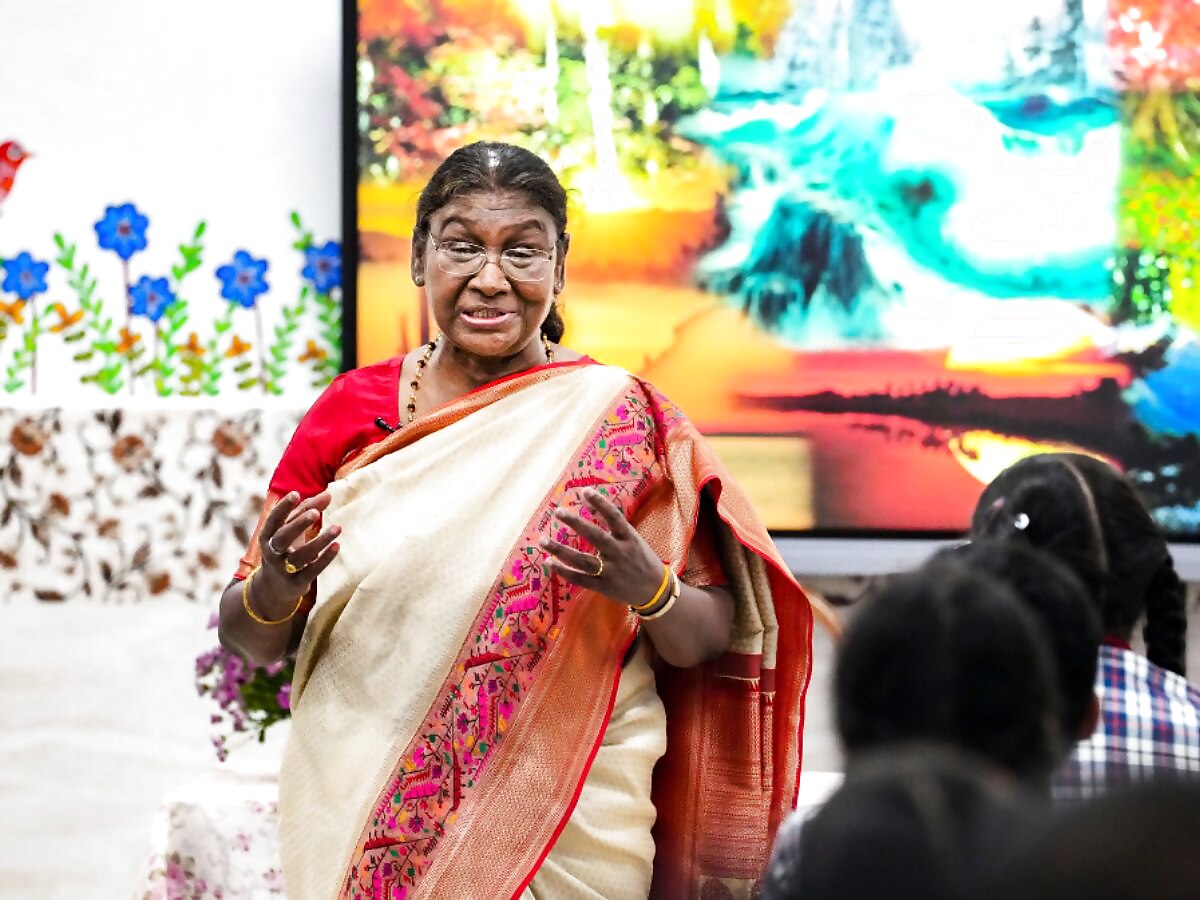
views
The grand structure, built as the Viceroy’s House on Raisina Hill in Delhi before Independence, came to be known as the Rashtrapati Bhavan on January 26, 1950. But it has taken over seven decades for all its rooms and areas to be freed from British influence. The process of Indianisation gained momentum at all levels after Prime Minister Narendra Modi came to power. Its impact is visible on the Rashtrapati Bhavan as well. Ram Nath Kovind, who became the President during the Modi era, started the Indianisation of all parts of the Rashtrapati Bhavan, while the final seal was put on it by current President Droupadi Murmu when she renamed ‘Durbar Hall’ and ‘Ashok Hall’ as ‘Ganatantra Mandap’ and ‘Ashok Mandap’, respectively.
During British rule, the Viceroy’s court was held in the Durbar Hall, but now all the state honours and awards of the Indian Republic are given here. Hence, it is appropriate to name it ‘Ganatantra Mandap’.
A long time coming
President Droupadi Murmu has completed two years in the highest constitutional office in the country. On this occasion, she changed the names of two important halls of the Rashtrapati Bhavan. Generally, when people talk about Rashtrapati Bhavan, the Durbar Hall and Ashok Mandap are discussed the most. After all, these are its two most beautiful, grand halls. Ashok Mandap is also known as the ‘large jewel box’ due to its grandeur.

These two rooms also have a deep connection with the history of independent India. While Jawaharlal Nehru was sworn in as the first Prime Minister of independent India on August 15, 1947, in the ‘Durbar Hall’, most of the subsequent Prime Ministers took oath in the Ashok Hall. In the present era, the Durbar Hall is used largely for conferring state, civil, and military honours, while the heads of foreign missions present their credentials in the Ashok Hall.
Hence, it is appropriate that as Droupadi Murmu completed two years of her tenure as the President, the names of both these halls were Indianised. Now, the Durbar Hall will be known as Ganatantra Mandap, while the Ashok Hall will be called Ashok Mandap. It is a big question as to why the hall in which the first Prime Minister of independent India took oath continued to be called the Durbar Hall even after seven decades of Independence. As the representative of the British monarch, the Viceroy could hold his durbar (court) here, which is why it was called Durbar Hall. But even after independent India formally became a Republic on January 26, 1950, it was still called Durbar Hall as no one paid attention to it. It is difficult to say whether this happened only due to carelessness or it was a symbol of our mentality in which the British or the names given by them were always considered the best. The good thing is that the occasion of Droupadi Murmu completing two years as President became the trigger for this necessary change.

How times changed, and some things didn’t
During pre-Independence British rule, the Viceroy’s House was built as the greatest symbol of British authoritarianism and sovereign power, housing the Viceroy as the representative of the monarch. That’s why it was called Viceroy’s House. After achieving Independence on August 15, 1947, it came to be known as Government House, in which Chakravarti Rajagopalachari, or Rajaji, entered as the first Indian Governor General on June 21, 1948. After the Constitution of India was implemented, it came to be known as the Rashtrapati Bhavan on January 26, 1950. Rajendra Prasad stayed in it as the first President of India for over 12 years.
After Rajendra Babu, it has been the residence of many Presidents one after the other, while everyone made some effort to enhance its beauty. Since Rajaji’s time, all 16 people who have held the highest constitutional office in the country never occupied the rooms meant for the use of the Viceroy but instead converted them into a guest house and lived in relatively smaller rooms. Droupadi Murmu is also following the same tradition.
Murmu and Kovind’s efforts
During her time, President Murmu also paid special attention to the library of Rashtrapati Bhavan, which is now known as Saraswati. Indian values and symbols are well reflected in this library. In terms of design, Swastika made of marble was put on the floor, while Lord Ganesh’s figure was placed on the wall. The table and chair below it have been used by all the Presidents whenever they visited the library.

It is not just that the library has been given an Indian name. The process started during the tenure of Ram Nath Kovind, who was the first President during the Modi regime. Prime Minister Modi himself has emphasised promoting Indian values in all aspects of governance, and its reflection is now visible in Rashtrapati Bhavan as well.
In fact, for seven decades after Independence, the names of the remaining halls and areas of Rashtrapati Bhavan were left as they were. These were according to the needs of the Viceroy during the British rule and as per British values. But during the Modi era, the pace of Indianisation gained momentum. Many of these names were changed during the tenure of Ram Nath Kovind as the President. And this continues during current President Droupadi Murmu’s tenure. Durbar Hall becoming Ganatantra Mandap and Ashok Hall becoming Ashok Mandap is a result of these incremental efforts.
Making way for rivers
Due to these efforts, the Banquet Hall suitable for state banquets is now known as Brahmaputra. Banquets are hosted here by the President in honour of foreign guests. Also, the food served here is now vegetarian, while alcohol has been prohibited.
The place where President Murmu meets visitors is now known as Sabarmati. Most of the sections of the Rashtrapati Bhavan have been given new names after the major rivers of India. For example, the Long Drawing Room where the President hosts the conference of Governors and Lieutenant Governors every year is now known as Tungabhadra.

The North Drawing Room adjacent to the Durbar Hall, where the President meets visiting heads of state, has been renamed Saryu. Lord Ram’s Ayodhya is situated on the banks of Saryu, which is counted as one of the holiest rivers of India. The Morning Room where the President usually holds routine meetings has now been named after Kaveri, the famous river of the south. Many important chambers have also been named after holy rivers like Yamuna, Godavari, Mahanadi, and Narmada. The new name of the Committee Room is Yamuna, while the Grey Dining Room has now become Narmada. President Droupadi Murmu, whose name is based on an important female character in the epic Mahabharata, uses all these rooms for different purposes.
Murmu’s inspiring journey
President Murmu, who comes from a poor tribal family in Odisha, was first an MLA and minister in Odisha and then became the Governor of the neighbouring state of Jharkhand during Prime Minister Narendra Modi’s government. She became the first woman tribal Governor of the tribal-dominated Jharkhand state.
Droupadi Murmu became the President of the country two years ago after efficiently performing the role of the Jharkhand Governor. She took oath as the 15th President of the country on July 25, 2022. With this, another record was also made. For the first time, a person coming from the tribal community sat on the highest constitutional post in the country. This was a clear representation of the strength of Indian democracy and the inclusive thinking of the Modi-led government.
Droupadi Murmu has spent two years as the President with great ease and simplicity. She has been seen communicating with the general public during her visits across various states in the country and has even worked towards boosting the morale of officers and soldiers by sitting in a fighter plane as the supreme commander of the Indian armed forces. Her subjects of interest range from environment to education as well as women’s upliftment.
A glimpse of this was also seen recently when she completed two years as President. She went to teach children in the Kendriya Vidyalaya inside the President’s Estate, which is named after the country’s first President Rajendra Prasad, and which was inaugurated by him during his last few days as President on May 5, 1962. Later on, this school came to be known as Sarvodaya School under the Delhi Government and since 2019, it has been named Kendriya Vidyalaya, where nowadays children are even being taught about Artificial Intelligence.

President Murmu also opened the Pranab Mukherjee Library for the general public, which was earlier only accessible to the employees associated with the Rashtrapati Bhavan and people living inside the President’s Estate. Now any person coming to visit the Rashtrapati Bhavan Museum can come to this library and get information about the journey of the Rashtrapati Bhavan, the Indian Constitution, and Father of the Nation Mahatma Gandhi. In this library, children’s interests have also been taken care of.
During her early days, Droupadi Murmu was a teacher, and hence she knows the importance of books very well. Therefore, not only was a collection of her speeches published by the Rashtrapati Bhavan but also two books on the Rashtrapati Bhavan were published on the occasion of Murmu completing two years as President. While one of these books tells children about the Rashtrapati Bhavan in a simple way, another book narrates the journey of lending a completely Indian style to the Rashtrapati Bhavan, including the efforts for its preservation.
People coming from the tribal community are usually uncomplicated. Despite sitting on the highest constitutional seat in the country, Draupadi Murmu has not lost her simplicity. Witnesses to this are all the common people and VIPs in the country and abroad who have come in contact with her. As President Murmu occupies this chair, it sends out a message to the poorest of the poor in the country that in the democratic system of India, any poor, backward, or tribal person can attain the highest position, and it is not the inheritance of any particular class.




















Comments
0 comment